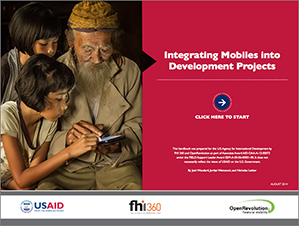Handbook: Integrating Mobiles into Development Projects


How is this handbook intended to be used?
The primary audience of this handbook is USAID staff, although much of the content is relevant to anyone interested in integrating mobiles into development projects more effectively. Most of the examples highlighted are from Southeast Asia, although the relevance of the content is global. Since the mobiles for development space is evolving rapidly, the handbook is intended to equip readers with a set of questions to ask when using or considering mobiles, rather than providing a prescription for how to use mobiles in a given country or sector.
The handbook is divided into two sections.The first section is entitled Understand, and is meant to be an in-depth guide of everything you might need to know about mobiles.The second section is entitled Implement. It provides practical tips and information related to integrating mobiles into a project in practice.The components in the Implement section mirror the different phases associated with USAID programming to situate you in a familiar framework when introducing new concepts and topics.
The two sections and each component within them are designed to be complementary, although they do not need to be read sequentially. Call-out boxes and tips are placed throughout the handbook to allow you to quickly scan and rapidly identify specific issues of interest.Worksheets and other relevant resources are included in the Resources section towards the end of the handbook. Several of the resources are editable forms that you can type directly into. The resources section also includes a Glossary of Terms and an M4D Inventory and list of USAID Projects using mobiles, which provide an overview of the many different mobile services and applications being used in development programs in Southeast Asia.
Below is an overview of the handbook’s five components within its two sections:
UNDERSTAND
- Understanding Mobiles for Development provides an overview of almost everything that you would need to know about using mobiles for development (M4D). It includes an explanation of the different mobile devices and delivery models that currently exist, the different functional uses of mobiles, the difference between open source and proprietary software, and much more. Last, it includes some examples of how mobiles are being used for development in Southeast Asia to give you an idea of what is already being done.
- Understanding the Mobile Ecosystem provides a breakdown of the different elements that make up the mobile ecosystem and an overview of the basic building blocks for any M4D intervention. In other words, it covers everything you need to know about the elements that need to be in place before it is possible to effectively use mobiles for development. It also includes some ideas about the role that USAID can play in helping to strengthen the mobile ecosystem.
IMPLEMENT
- Project Design focuses on techniques for integrating mobiles into project design. It starts by providing lessons learned for good M4D design, followed by a six-step process for integrating mobiles into concept design. It introduces both sectoral and context-specific considerations that should be kept in mind when designing a concept, as well as providing an introduction to user-centered design and resources for employing this approach into one’s own work.
- Procurementdeals with the nuts and bolts of incorporating mobiles into solicitations. Building upon the project design component, it further explores how to determine the pre-requisites and requirements for using mobiles in a development project. It also covers techniques for calculating associated costs and comparing the costs and benefits of mobiles over other methods. Finally, it includes suggestions for critically evaluating solicitation responses with mobile device components.
- Monitoring Implementation and Program Evaluation is written with a focus on enabling you to effectively monitor and evaluate the implementation of M4D activities. It includes an introduction to some of the commonly used indicators for determining the impact of mobile-based activities, as well as tips for critically assessing project outputs. Finally, it includes suggestions for how to evaluate the impact that mobiles are having on a project.
Suggested citation
Woodard, J., Weinstock, J., Lesher, N. 2014. Integrating Mobiles into Development Projects. USAID.
(0) Comments
There is no content